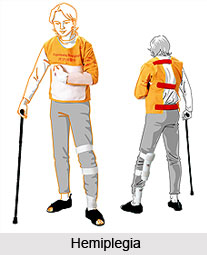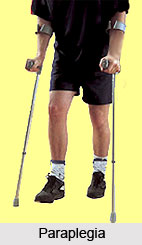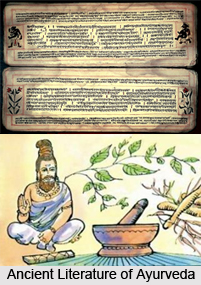 Paralysis or palsy means loss of muscular power due to interference with the nervous system. When muscular power is weakened as the result of some affection of the nervous system, the term applied is paralysis. Various technical names are given to various forms of the disease.
Paralysis or palsy means loss of muscular power due to interference with the nervous system. When muscular power is weakened as the result of some affection of the nervous system, the term applied is paralysis. Various technical names are given to various forms of the disease.
Some different types of paralysis can be mentioned as
Hemiplegia: this type is applied to paralysis affecting one part of the face, along with the corresponding arm and leg.
Diplegia means a condition of more or less total paralysis.
Monoplegia is the paralysis of a single limb; and
Paraplegia signifies paralysis of both sides of the body below a given level, usually from about the level of the waist.
Creeping paralysis is a vague term applied most often to locomotor ataxia;
Shaking paralysis is the popular name for paralysis agitans; and
Wasting paralysis commonly means progressive muscular atrophy.
Causes and Symptoms: Paralysis is classified according to whether it depends on the disease of the brain, spinal cord, or nerves. Hence the terms can be used as cerebral, spinal, and peripheral paralysis. The most common form of paralysis due to brain disease is hemiplegia, which arises from a disease of the hemisphere of the brain opposite to the side of the body affected.
 It may occur due to haemorrhage in the brain or blocking of the blood vessels. In this type one side of the body loses all muscular tone and the muscles eventually hang loose. Trembling palsy, also called paralysis agitans, Parkinsonism, or shaking paralysis is characterized by rhythmical tremors and rigidity of the muscles. It is a chronic disease of advanced life and is due to degenerative changes in the base of the cerebrum.
It may occur due to haemorrhage in the brain or blocking of the blood vessels. In this type one side of the body loses all muscular tone and the muscles eventually hang loose. Trembling palsy, also called paralysis agitans, Parkinsonism, or shaking paralysis is characterized by rhythmical tremors and rigidity of the muscles. It is a chronic disease of advanced life and is due to degenerative changes in the base of the cerebrum.
At first, symptoms appear in the form of involuntary trembling of the limbs, which ceases during sleep. Cerebral palsy is characterized by varying degrees of paralysis, generally, spastic paralysis. Paraplegia is the paralysis of both lower extremities, including usually the lower portion of the trunk. It is sometimes the result of injuries to the spinal column. Wasting palsy is a disease of middle age. The gradual wasting of certain muscles or groups of muscles, loss of power in them, twitching of the muscle fibres, and alteration of tendon and skin reflexes, characterize it. Progressive muscular atrophy results from these symptoms and is caused by a process of degeneration in the motor cells in the cerebral cortex, the cells of grey matter of the spinal cord, and the nerve cells in the brain. Facial paralysis is another variety of the disease that attacks the muscles of the face.
Medicines & Prescriptions: The following prescriptions, either singly or in combination with others, may be tried as medicine
1. Rasnadi Qualh: 50 ml to be taken daily.
2. Ashwagandha Churna; Chopcheeni Churna; Vatavidhwamsana Rasa; Pippali Mula: 1 gm each of Ashwagandha Churna and Chopcheeni Churna, 60 mg of
Vatavidhwamsana Rasa and 1 gm of Pippali Churna to be taken thrice daily.
3. Medicated Castor oil: 20 ml to be given in the morning with milk.
4. Mashabaladi Qualh: Asafoelida; Rock salt: 50 ml Mashabaladi Quath, 60 mg
Asafoetida, and 500 mg Rock salt to be used as nasal drops opposite to the side affected.
5. Brihat Vatachintamani Rasa: Ashwagandha Churna: 30 mg Brihat Vatachintamani Rasa and 1 gm Ashwagandha Churna to be taken twice daily with meat soup.
6. Mahanarayana Taila: 20 ml to follow No 5 above, it should be mixed with milk.
7. Rasaraja: 120 mg to be taken last thing at night with milk
In addition to all these Kupiloo Taila should be rubbed on the affected part. Siddha Makaradhwaja, Malla Chandrodaya, Trailokya Chintamani, Vatanashan Rasa, Navagrahi Shiroraja are some of the other standard Ayurvedic preparations that are helpful in dealing with paralysis. If needed, they may be combined with any of the above seven prescriptions.
Diet and Other Regimen: Light, easily digestible food should be taken. The patient is advised to undergo physiotherapy for the afflicted parts of his body so as to sustain their strength.




















